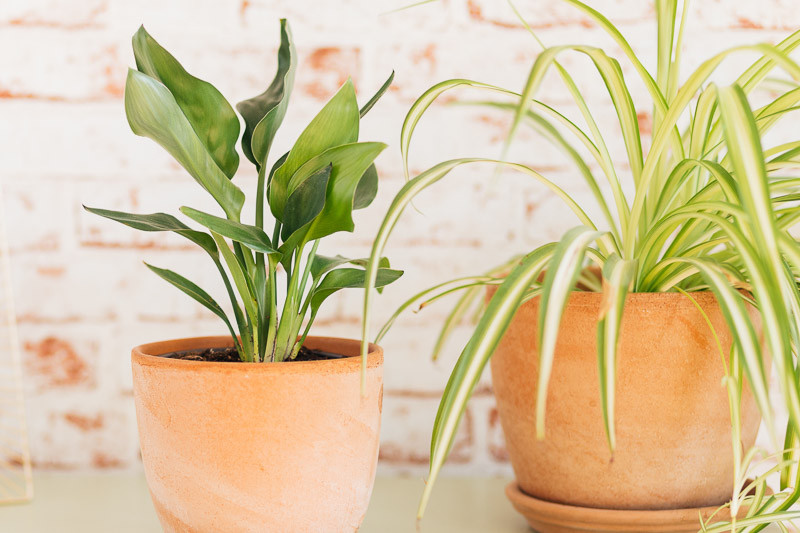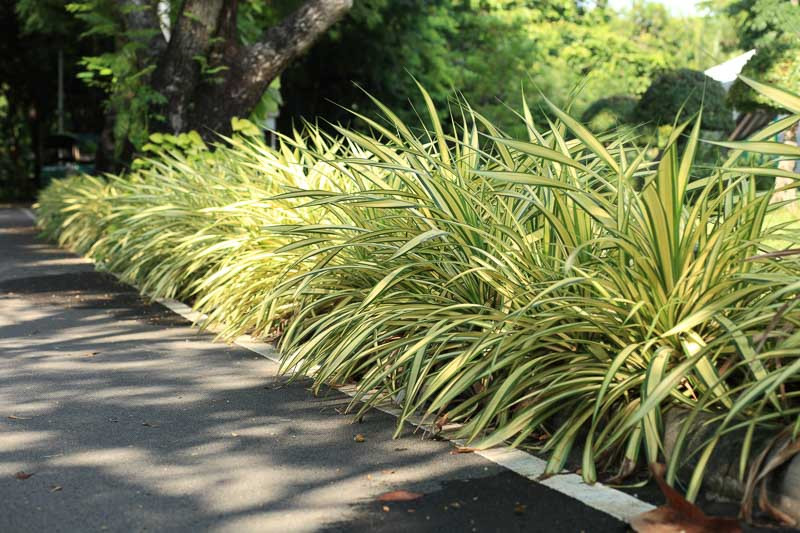Spider Plant, Spider Ivy, Ribbon Plant
The spider plant (Chlorophytum comosum) is a popular, easy-to-grow houseplant native to tropical and southern Africa. It is known for its attractive, long, arching leaves with a central green stripe and white or yellowish margins. The plant is also called airplane plant, ribbon plant, or spider ivy.
Description: Spider plants have slender, arching leaves that grow from a central rosette, giving them a grass-like appearance. Depending on the cultivar, the leaves can be solid green, variegated green and white, or green and yellow.
Growth habit: The plant grows rapidly and produces offshoots called “spiderettes” or “pups” at the ends of long, slender stems called stolons. These spiderettes can be rooted easily to create new plants.
Size: A mature spider plant can reach a height of 12-24 inches (30-60 cm) and a spread of 12-36 inches (30-90 cm).
Flowers: Spider plants produce small, star-shaped, white flowers on long, arching stems. The flowers are not particularly showy, but they add a delicate touch to the plant’s overall appearance.
Blooming season: Flowering usually occurs during the summer months.
Hardiness: Spider plants are not frost-tolerant and are typically grown as houseplants in most climates. They can be grown outdoors in USDA Hardiness Zones 9-11.
Uses: Spider plants are primarily grown for their attractive foliage and ease of care. The tropical plants are popular as houseplants, hanging basket plants, and in mixed containers. They are also known for their air-purifying qualities, as they can remove common indoor air pollutants.
Toxicity: Spider plants are non-toxic to pets and humans.
Spider plants are special for a variety of reasons, making them a popular choice for indoor gardening enthusiasts. Some of the unique characteristics that set them apart are:
Air-purifying properties: Spider plants are known for removing common indoor air pollutants, such as formaldehyde, benzene, and xylene. A NASA study found them to be among the top air-purifying houseplants.
Easy propagation: Spider plants produce offshoots called “spiderettes” or “pups” that can be easily removed from the parent plant and rooted to create new plants. This makes propagating spider plants quick and straightforward, even for beginners.
Low maintenance: These plants are incredibly easy to care for, making them perfect for inexperienced or busy gardeners. They can tolerate a range of light conditions and can also withstand periods of neglect and drought.
Attractive foliage: Spider plants have long, arching leaves with various color patterns, depending on the cultivar. The most common variety has green leaves with white or yellowish margins, which adds a visually appealing touch to any indoor space.
Adaptability: Spider plants can be grown in a variety of containers, such as hanging baskets, pots, or mixed with other plants in larger containers. Their adaptability makes them suitable for various indoor settings, from offices to living rooms.
These unique features make spider plants an excellent choice for adding greenery to your indoor environment while also improving air quality and requiring minimal care.

To keep your spider plant healthy and thriving, follow these care guidelines:
Light: Spider plants prefer bright, indirect light but are quite adaptable and can also thrive in partial shade or low-light conditions. Optimal growth and variegation are achieved with more light, but this plant’s versatility makes it suitable for various indoor lighting environments.
If you’re growing spider plants outdoors, choose a location with dappled shade or partial sun. They can tolerate some direct morning sun, but it’s important to protect them from harsh afternoon sun to prevent leaf burn. Ideally, provide them with 4-6 hours of filtered sunlight or bright shade for the best growth.
When transitioning your spider plant from indoors to outdoors, do so gradually. Introduce the plant to outdoor conditions by placing it in a shady spot for a few days, gradually increasing the exposure to filtered sunlight over the course of 1-2 weeks. This process, known as “hardening off,” helps the plant acclimate to its new environment and prevents shock or damage.
Soil: Whether grown indoors or outdoors, spider plants require well-draining soil to thrive. The ideal soil mixture for spider plants should be light, airy, and able to retain some moisture without becoming waterlogged.
For indoor spider plants, use a high-quality all-purpose potting mix that contains a blend of peat moss, vermiculite, and perlite.
For outdoor spider plants, select a garden bed with well-draining soil. If your garden soil is heavy clay or tends to hold water, amend it with organic matter such as compost, aged manure, or leaf mold, as well as perlite or sand to improve drainage. A slightly acidic to neutral soil pH of 6.0-7.0 is ideal for spider plants.
Watering: Water your spider plant when the top inch of soil feels dry to the touch. Water thoroughly, allowing the excess water to drain out of the pot’s bottom. Avoid overwatering, as this can lead to root rot. Spider plants prefer evenly moist soil but can tolerate brief periods of drought.
Humidity: Spider plants appreciate moderate humidity levels (40-50%). You can maintain humidity by placing a tray filled with water and pebbles under the pot or occasionally misting the plant. However, they can also tolerate average indoor humidity levels.
Temperature: These plants prefer temperatures between 65-75°F (18-24°C) and can tolerate a range of 55-85°F (13-29°C). Avoid exposing them to temperatures below 50°F (10°C), as this can cause damage to the foliage.
Fertilization: Feed your spider plant every 4-6 weeks during the growing season (spring and summer) with a balanced, water-soluble houseplant fertilizer diluted to half the recommended strength. Avoid over-fertilizing, as this can cause leaf tip burn.
Repotting: Spider plants prefer to be slightly root-bound, so repot them only when necessary, usually every 2-3 years. Choose a pot one size larger than the current pot, with drainage holes to prevent root rot.
Pruning: Regularly remove any brown or yellow leaves by cutting them at the base. This will encourage new growth and maintain the plant’s overall health.
Propagation: Spider plants are easy to propagate through their spiderettes. Simply cut a healthy spiderette from the mother plant and place it in a container of water or directly into moist soil. Roots should start to form within a few weeks.
By providing the proper care and conditions, your spider plant will continue to grow and thrive, adding beauty and cleaner air to your indoor space.

Spider plants are relatively hardy and low-maintenance, but they can still encounter a few common problems. Here’s a list of potential issues and how to address them:
By addressing these common issues promptly, you can ensure your spider plant remains healthy and vibrant. Regularly check your plant for signs of stress or pests to catch potential problems early.
Propagating a spider plant is quite easy, as they naturally produce small plantlets or “spiderettes” that can be used for propagation. There are two common methods to propagate spider plants: water propagation and soil propagation. Here’s a step-by-step guide for each method:
In both methods, it’s important to maintain a consistent temperature of 65-75°F (18-24°C) and provide bright, indirect light for optimal growth. With proper care, your new spider plant will grow into a healthy, mature plant.

Spider plants are considered non-toxic to both cats and dogs. According to the ASPCA, they are safe for pets. However, it is still best to discourage your pets from chewing on plants, as ingesting any plant material can cause mild gastrointestinal upset in some animals.
Water your spider plant when the top inch of the soil feels dry to the touch. Water the plant thoroughly, allowing the excess water to drain out of the pot’s bottom. Spider plants prefer evenly moist soil but can tolerate brief periods of drought. The frequency of watering will depend on factors like the size of the pot, the potting mix, and the environment. Generally, you may need to water your spider plant every 7-10 days, but always check the soil moisture before watering.
To get rid of spider mites on indoor plants, follow these steps:
| Hardiness |
9 - 11 |
|---|---|
| Heat Zones |
10 - 11 |
| Climate Zones | 15, 16, 17, 19, 20, 21, 22, 23, 24, H1, H2 |
| Plant Type | Houseplants, Perennials |
| Plant Family | Asparagaceae |
| Exposure | Partial Sun |
| Season of Interest |
Spring (Early, Mid, Late) Summer (Early, Mid, Late) Fall Winter |
| Height |
1' - 2' (30cm - 60cm) |
| Spread |
1' - 2' (30cm - 60cm) |
| Spacing | 24" (60cm) |
| Maintenance | Low |
| Water Needs | Low, Average |
| Soil Type | Chalk, Clay, Loam, Sand |
| Soil pH | Acid, Alkaline, Neutral |
| Soil Drainage | Moist but Well-Drained, Well-Drained |
| Characteristics | Showy, Evergreen |
| Tolerance | Full Shade, Drought |
| Garden Uses | Beds And Borders, Patio And Containers |
| Garden Styles | Mediterranean Garden |
Ikhsan Rosyadi, Julia Dresch, Shutterstock
| Hardiness |
9 - 11 |
|---|---|
| Heat Zones |
10 - 11 |
| Climate Zones | 15, 16, 17, 19, 20, 21, 22, 23, 24, H1, H2 |
| Plant Type | Houseplants, Perennials |
| Plant Family | Asparagaceae |
| Exposure | Partial Sun |
| Season of Interest |
Spring (Early, Mid, Late) Summer (Early, Mid, Late) Fall Winter |
| Height |
1' - 2' (30cm - 60cm) |
| Spread |
1' - 2' (30cm - 60cm) |
| Spacing | 24" (60cm) |
| Maintenance | Low |
| Water Needs | Low, Average |
| Soil Type | Chalk, Clay, Loam, Sand |
| Soil pH | Acid, Alkaline, Neutral |
| Soil Drainage | Moist but Well-Drained, Well-Drained |
| Characteristics | Showy, Evergreen |
| Tolerance | Full Shade, Drought |
| Garden Uses | Beds And Borders, Patio And Containers |
| Garden Styles | Mediterranean Garden |
How many Chlorophytum comosum (Spider Plant) do I need for my garden?
| Plant | Quantity | |
|---|---|---|
| Chlorophytum comosum (Spider Plant) | N/A | Buy Plants |
Create a membership account to save your garden designs and to view them on any device.
Becoming a contributing member of Gardenia is easy and can be done in just a few minutes. If you provide us with your name, email address and the payment of a modest $25 annual membership fee, you will become a full member, enabling you to design and save up to 25 of your garden design ideas.
Join now and start creating your dream garden!
Create a membership account to save your garden designs and to view them on any device.
Becoming a contributing member of Gardenia is easy and can be done in just a few minutes. If you provide us with your name, email address and the payment of a modest $25 annual membership fee, you will become a full member, enabling you to design and save up to 25 of your garden design ideas.
Join now and start creating your dream garden!